Related Research Articles
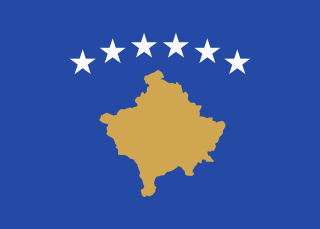
Kosovo, officially the Republic of Kosovo, is a country in Southeast Europe with partial diplomatic recognition. Kosovo lies landlocked in the centre of the Balkans, bordered by Serbia to the north and east, North Macedonia to the southeast, Albania to the southwest, and Montenegro to the west. Most of central Kosovo sits on the plains of Metohija and the Kosovo field. The Accursed Mountains and Šar Mountains rise in the southwest and southeast, respectively. Kosovo's capital and largest city is Pristina.
This article includes information on the demographic history of Kosovo.

Peja is the fourth most populous city in Kosovo and serves as the seat of the Peja Municipality and the District of Peja. It is located in the Rugova region on the eastern section of the Accursed Mountains along the Lumbardhi i Pejës River in the western part of Kosovo.

Prizren is the second most populous city and municipality of Kosovo and seat of the eponymous municipality and district. It is located on the banks of the Prizren River between the foothills of the Sharr Mountains in southern Kosovo. Prizren experiences an oceanic climate under the influence of the surrounding mountains.

The League of Prizren, officially the League for the Defense of the Rights of the Albanian Nation, was an Albanian political organization that was officially founded on June 10, 1878 in the old town of Prizren in the Kosovo Vilayet of the Ottoman Empire. It was suppressed in April 1881.
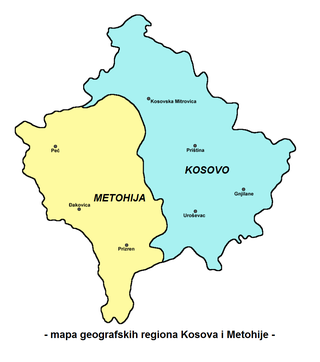
Metohija or Dukagjin is a large basin and the name of the region covering the southwestern part of Kosovo. The region covers 35% (3,891 km2) of Kosovo's total area. According to the 2011 census, the population of the region is 700,577.
Llap Region is a region located in the north-eastern part of Kosovo. Llap in the broadest sense includes the watershed of the Llapi River. The Llapi water collection begins in the mountains of Kopaonik in the north and west and its source is considered to be the village of Pollatë, and ends by joining the Sitnica river in Lumadh, municipality of Vushtrri, in the north-west of Pristina. The topographic watershed of the Llapi River covers an area of 945.4 km2 (365.0 sq mi).
The history of Kosovo dates back to pre-historic times when the Starčevo culture, Vinča culture, Bubanj-Hum culture, and Baden culture were active in the region. Since then, many archaeological sites have been discovered due to the abundance of natural resources which gave way to the development of life.
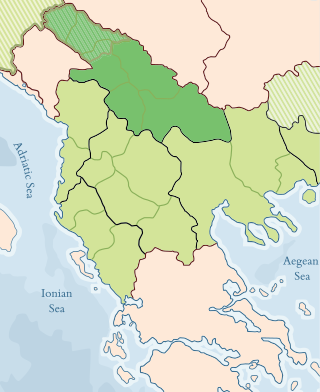
The Vilayet of Kosovo was a first-level administrative division (vilayet) of the Ottoman Empire in the Balkan Peninsula which included the modern-day territory of Kosovo and the north-western part of the Republic of North Macedonia. The areas today comprising Sandžak (Raška) region of Serbia and Montenegro, although de jure under Ottoman control, were de facto under Austro-Hungarian occupation from 1878 until 1909, as provided under Article 25 of the Treaty of Berlin. Üsküb (Skopje) functioned as the capital of the province and the midway point between Istanbul and its European provinces. Üsküb's population of 32,000 made it the largest city in the province, followed by Prizren, also numbering at 30,000.
Muhaxhir and Muhaxher are Ottoman Albanian communities that left their homes as refugees or were transferred, from Greece, Serbia and Montenegro to Albania, Kosovo and to a lesser extent North Macedonia during and following various wars.
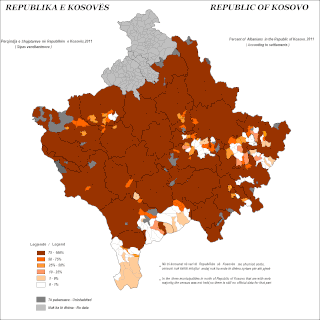
The Albanians of Kosovo, also commonly called Kosovo Albanians, Kosovan Albanians or Kosovars, constitute the largest ethnic group in Kosovo.
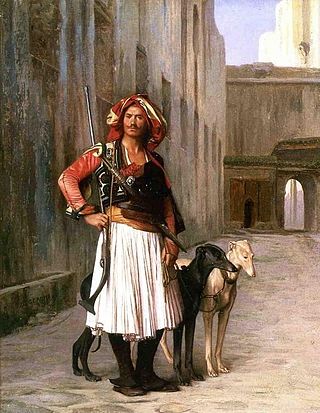
Arnaut is a Turkish ethnonym used to denote Albanians. Arvanid (اروانيد), Arnavud (آرناوود), plural: Arnavudlar (آرناوودلر): modern Turkish: Arnavut, plural: Arnavutlar; are ethnonyms used mainly by Ottoman and contemporary Turks for Albanians with Arnavutça being called the Albanian language. Arnavudluk (آرناوودلق) was the Ottoman Turkish geographical designation of the Albanian regions, including areas such as present-day Albania, Kosovo, western North Macedonia, southern Serbia, southern Montenegro and parts of northern Greece.
This is a timeline containing events regarding the history of Kosovo.

The Kingdom of Serbia was one of the major parties in the Balkan Wars, gaining land in both conflicts. It experienced significant territorial gains in the Central Balkans, nearly doubling its territory.

The Albanian Vilayet was a projected vilayet of the Ottoman Empire in the western Balkan Peninsula, which was to include the four Ottoman vilayets with substantial ethnic Albanian populations: Kosovo Vilayet, Scutari Vilayet, Manastir Vilayet, and Janina Vilayet. In some proposals, it included the Salonica Vilayet as well. The creation of the Vilayet was confirmed in September 1912, but negotiations were interrupted a month later in October by the beginning of the First Balkan War. Plans for an Albanian Vilayet were lost with the Partition of Albania.

The Sanjak of Prizren was one of the sanjaks in the Ottoman Empire with Prizren as its administrative centre. It was founded immediately after Ottoman Empire captured Prizren from Serbian Despotate in 1455. The rest of the territory of Serbian Despotate was conquered after the fall of Smederevo in 1459, and divided into following sanjaks: Sanjak of Viçitrina, Sanjak of Kruševac and Sanjak of Smederevo. At the beginning of the First Balkan War in 1912, the territory of Sanjak of Prizren was occupied by the army of the Kingdom of Serbia. Based on Treaty of London signed on 30 May 1913, the territory of Sanjak of Prizren became part of Serbia.
The Sanjak of Niš was one of the sanjaks of the Ottoman Empire and its county town was Niš. It was composed of the kazas of Niš (Niş), Pirot (Şehirköy), Leskovac (Leskofça), Vranje (İvranye), Kuršumlija (Kurşunlu), Prokuplje (Ürküp) and Tran (Turan).
During the Austro-Turkish War of 1716–18, after Austrian military success, Serb peasants rose up against Ottoman rule in the Sanjak of Viçitrina, and also Novi Pazar and Peja in 1717. The rebellion was brutally suppressed by Ottoman troops.
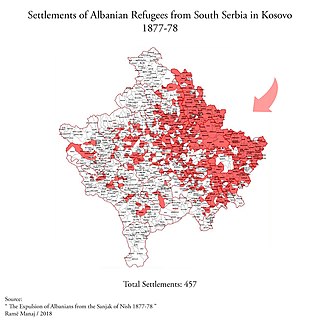
The expulsion of the Albanians, 1877–1878 refers to events of forced migration of Albanian populations from areas that became incorporated into the Principality of Serbia and Principality of Montenegro in 1878 after their initial expulsion from 1830–1876. These wars, alongside the larger Russo-Ottoman War (1877–78) ended in defeat and substantial territorial losses for the Ottoman Empire which was formalised at the Congress of Berlin. This expulsion was part of the wider persecution of Muslims in the Balkans during the geopolitical and territorial decline of the Ottoman Empire.
Kosovo is the birthplace of the Albanian nationalist movement which emerged as a response to the Eastern Crisis of 1878. In the immediate aftermath of the Russo-Ottoman war, the Congress of Berlin proposed partitioning Ottoman Albanian inhabited lands in the Balkans among neighbouring countries. The League of Prizren was formed by Albanians to resist those impositions. For Albanians those events have made Kosovo an important place regarding the emergence of Albanian nationalism. During the remainder of the late Ottoman period various disagreements between Albanian nationalists and the Ottoman Empire over socio-cultural rights culminated in two revolts within Kosovo and adjacent areas. The Balkan Wars (1912–13) ending with Ottoman defeat, Serbian and later Yugoslav sovereignty over the area generated an Albanian nationalism that has become distinct to Kosovo stressing Albanian language, culture, and identity within the context of secession from Serbia. Pan-Albanian sentiments are also present and historically have been achieved only once when part of Kosovo was united by Italian Axis forces to their protectorate of Albania during the Second World War.
References
- ↑ Chisholm, Hugh, ed. (1911). . Encyclopædia Britannica . Vol. 15 (11th ed.). Cambridge University Press. p. 916.
- ↑ Fábián & Trost 2019 , p. 349
- ↑ Albanian Etymological Dictionary, V.Orel, Koninklijke Brill, Leiden Boston Köln 1998, p.56
- ↑ Wilkes, John (1992). The Illyrians. Wiley. p. 244. ISBN 9780631146711. "Names of individuals peoples may have been formed in a similar fashion, Taulantii from ‘swallow’ (cf. the Albanian tallandushe) or Erchelei the ‘eel-men’ and Chelidoni the ‘snail-men’. The name of the Delmatae appears connected with the Albanian word for ‘sheep’ delmë) and the Dardanians with for ‘pear’ (dardhë)."
- ↑ Jelle Janssens (5 February 2015). State-building in Kosovo. A plural policing perspective. Maklu. pp. 51–. ISBN 978-90-466-0749-7.
- ↑ J. Everett-Heath (1 August 2000). Place Names of the World - Europe: Historical Context, Meanings and Changes. Palgrave Macmillan UK. pp. 373–. ISBN 978-0-230-28673-3.
- 1 2 Kosta Mihailović, ed. (2006). Kosovo and Metohija: past, present, future : papers presented at the International Scholarly Meeting held at the Serbian Academy of Sciences and Arts, Belgrade, March 16-18, 2006. SANU. pp. 231–233. ISBN 9788670254299.
- ↑ Ivana Vidović, ed. (2001). Drugi hrvatski slavistički kongres: zbornik radova. Hrvatsko filološko društvo. p. 72. ISBN 978-953-175-112-4.
- ↑ Van Wijk, 'Taalkunde gegevens', p. 71.
- ↑ "Kosovo: Only Independence Will Work". nationalinterest.org. 1 December 1998.
- 1 2 Ducellier, Alain (2006). Di Lellio, Anna (ed.). The Case for Kosova: Passage to Independence. Anthem Press. pp. 30–31. ISBN 9781843312451.
- 1 2 3 4 5 Anscombe 2006b , p. 787.
- ↑ Anscombe, Frederick (2006). "Albanians and "mountain bandits"". In Anscombe, Frederick (ed.). The Ottoman Balkans, 1750–1830. Princeton: Markus Wiener Publishers. pp. 87–113. ISBN 9781558763838. Archived from the original on 25 January 2016. p.88, 107 "In light of the recent violent troubles in Kosovo and Macedonia and the strong emotions tied to them, readers are urged most emphatically not to draw either of two unwarranted conclusions from this article: that Albanians are somehow inherently inclined to banditry, or that the extent of Ottoman "Albania" or Arnavudluk (which included parts of present-day northern Greece, western Macedonia, southern Montenegro, Kosovo, and southern Serbia) gives any historical "justification" for the creation of a "Greater Albania" today."
- ↑ Anscombe, Frederick (2006b). "The Ottoman Empire in Recent International Politics – II: The Case of Kosovo". The International History Review. 28 (4): 758–793. doi:10.1080/07075332.2006.9641103. JSTOR 40109813. S2CID 154724667. p.772.
- ↑ Kolovos, Elias (2007). The Ottoman Empire, the Balkans, the Greek lands: Toward a social and economic history: Studies in honor of John C. Alexander. Istanbul: Isis Press. ISBN 9789754283464. p. 41. "Anscombe (ibid., 107 n. 3) notes that Ottoman "Albania" or Arnavudluk... included parts of present-day northern Greece, western Macedonia, southern Montenegro, Kosovo, and southern Serbia"; see also El2. s.v. "Arnawutluk. 6. History" (H. İnalcık) and Arsh, He Alvania. 31.33, 39–40. For the Byzantine period. see Psimouli, Souli. 28."
- ↑ Gawrych, George (2006). The Crescent and the Eagle: Ottoman rule, Islam and the Albanians, 1874–1913. London: IB Tauris. pp. 28–29. ISBN 9781845112875.
- ↑ Bieber, Florian; Daskalovski, Zidas, eds. (2004). Understanding the War in Kosovo. Routledge. p. 44. ISBN 9781135761554.
- ↑ Clark, Howard (2000). Civil Resistance in Kosovo. Pluto Press. p. 219. ISBN 9780745315690.